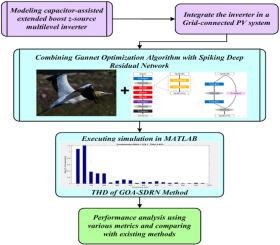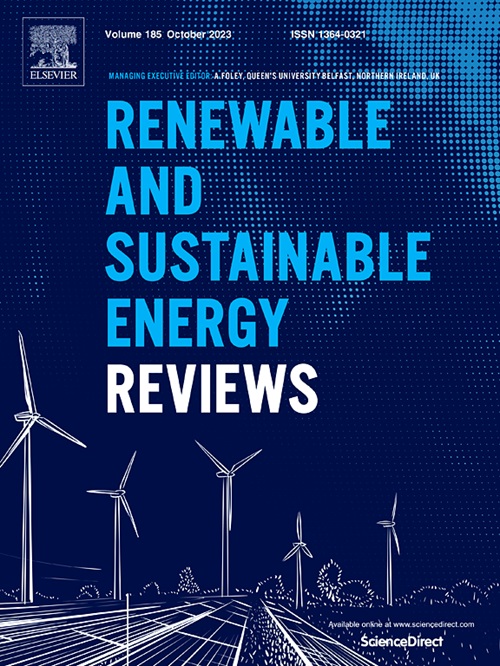Hybrid control for capacitor-assisted Z-source inverter in grid-connected photovoltaic system
IF 16.3
1区 工程技术
Q1 ENERGY & FUELS
引用次数: 0
Abstract
Renewable energy integration into the power grid is essential for sustainable energy systems, but maintaining efficiency and reliability in such systems remains a key challenge. This study introduces a novel hybrid control topology for a Capacitor-Assisted Extended Boost Z-Source Multilevel Inverter in a grid associated solar photovoltaic (PV) structure. The suggested hybrid technique implies a united implementation of a Gannet Optimization Algorithm and Spiking Deep Residual Network and usually referred as GOA-SDRN technique. Initially, the modelling of the inverter is collected to get the best signal by the proposed controller. The proposed inverter configuration consists of a minimal quantity of diodes, switches, and sources. This configuration also offers advantages like less total harmonic distortion (THD) and reduced electromagnetic interference, making it a favourable choice for PV integration. The GOA is employed to determine the most favourable gain limiting factor based on a variation of power from their regular values. This control method ideally satisfies the load demand while reducing changes in the system limiting factor and external disturbances. The proposed control topology is executed in MATLAB and the concept is contrasted to different techniques. The THD values of existing methods such as Particle Swarm Optimization, Genetic Algorithm, and Grasshopper Optimization Algorithm are 1.36 %,0.89 %, and 1.99 % respectively, while the THD value of the proposedmethod is 0.63 %, demonstrating its optimal performance over existing methods. The proposed GOA-SDRN technique provides an effective solution for enhancing inverter efficiency and reducing distortion in grid-associated PV systems.

并网光伏系统中电容器辅助 Z 源逆变器的混合控制
将可再生能源并入电网对可持续能源系统至关重要,但保持此类系统的效率和可靠性仍是一项关键挑战。本研究为电网相关太阳能光伏(PV)结构中的电容辅助扩展升压 Z 源多级逆变器引入了一种新型混合控制拓扑。所建议的混合技术意味着将甘尼特优化算法和尖峰深度残差网络联合起来实施,通常称为 GOA-SDRN 技术。首先,收集逆变器的建模,以便通过建议的控制器获得最佳信号。建议的逆变器配置由最少的二极管、开关和源组成。这种配置还具有总谐波失真(THD)小、电磁干扰少等优点,是光伏集成的有利选择。GOA 用于根据功率与常规值的差异确定最有利的增益限制因子。这种控制方法既能理想地满足负载需求,又能减少系统限制因子的变化和外部干扰。在 MATLAB 中执行了所提出的控制拓扑结构,并将这一概念与不同的技术进行了对比。粒子群优化、遗传算法和蚱蜢优化算法等现有方法的总谐波失真(THD)值分别为 1.36 %、0.89 % 和 1.99 %,而提议方法的总谐波失真(THD)值为 0.63 %,表明其性能优于现有方法。所提出的 GOA-SDRN 技术为提高逆变器效率和减少电网相关光伏系统的失真提供了有效的解决方案。
本文章由计算机程序翻译,如有差异,请以英文原文为准。
求助全文
约1分钟内获得全文
求助全文
来源期刊

Renewable and Sustainable Energy Reviews
工程技术-能源与燃料
CiteScore
31.20
自引率
5.70%
发文量
1055
审稿时长
62 days
期刊介绍:
The mission of Renewable and Sustainable Energy Reviews is to disseminate the most compelling and pertinent critical insights in renewable and sustainable energy, fostering collaboration among the research community, private sector, and policy and decision makers. The journal aims to exchange challenges, solutions, innovative concepts, and technologies, contributing to sustainable development, the transition to a low-carbon future, and the attainment of emissions targets outlined by the United Nations Framework Convention on Climate Change.
Renewable and Sustainable Energy Reviews publishes a diverse range of content, including review papers, original research, case studies, and analyses of new technologies, all featuring a substantial review component such as critique, comparison, or analysis. Introducing a distinctive paper type, Expert Insights, the journal presents commissioned mini-reviews authored by field leaders, addressing topics of significant interest. Case studies undergo consideration only if they showcase the work's applicability to other regions or contribute valuable insights to the broader field of renewable and sustainable energy. Notably, a bibliographic or literature review lacking critical analysis is deemed unsuitable for publication.
 求助内容:
求助内容: 应助结果提醒方式:
应助结果提醒方式:


